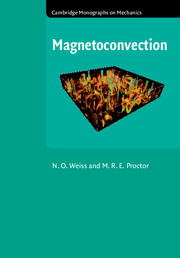Book contents
- Frontmatter
- Dedication
- Contents
- Preface
- 1 Introduction
- 2 Basic MHD
- 3 Linearized Boussinesq magnetoconvection
- 4 The nonlinear regime
- 5 2D Boussinesq magnetoconvection
- 6 3D Boussinesq magnetoconvection
- 7 Magnetoconvection, rotation and the dynamo
- 8 Compressible magnetoconvection
- 9 Solar and stellar magnetic fields
- Appendix A The Boussinesq and anelastic approximations
- Appendix B Chaotic systems
- Appendix C Double-diffusive convection
- Appendix D Magnetic buoyancy and the magneto-Boussinesq approximation
- References
- Index
4 - The nonlinear regime
Published online by Cambridge University Press: 05 November 2014
- Frontmatter
- Dedication
- Contents
- Preface
- 1 Introduction
- 2 Basic MHD
- 3 Linearized Boussinesq magnetoconvection
- 4 The nonlinear regime
- 5 2D Boussinesq magnetoconvection
- 6 3D Boussinesq magnetoconvection
- 7 Magnetoconvection, rotation and the dynamo
- 8 Compressible magnetoconvection
- 9 Solar and stellar magnetic fields
- Appendix A The Boussinesq and anelastic approximations
- Appendix B Chaotic systems
- Appendix C Double-diffusive convection
- Appendix D Magnetic buoyancy and the magneto-Boussinesq approximation
- References
- Index
Summary
We have seen that convection may set in at either a Hopf or a pitchfork bifurcation, giving rise to branches of nonlinear oscillatory or steady motion. In this chapter we consider weakly and mildly nonlinear behaviour, in regimes that are accessible to an analytical approach, without having to rely on large-scale computation. Our treatment relies on mathematical developments in nonlinear dynamics – a subject that has its roots in the work of Poincaré more than a century ago but has grown explosively during the past few decades. In what follows we shall adopt a straightforward approach that is aimed at traditional applied mathematicians rather than at experts in nonlinear mathematics. Magnetoconvection provides a rich and fascinating demonstration of the power of bifurcation theory, and of its ability to explain a wide range of interactions between branches of solutions that may be stable or unstable, steady, oscillatory or chaotic.
We shall confine our attention here to idealized models of Boussinesq magnetoconvection, and focus on two-dimensional behaviour. In subsequent chapters these restrictions will be progressively relaxed. We shall mainly be concerned with imposed magnetic fields that are vertical, but horizontal fields will be considered briefly in the final subsection. As in Section 3.1.4, we assume that the velocity u and the magnetic field B are confined to the xz-plane and independent of y.
- Type
- Chapter
- Information
- Magnetoconvection , pp. 64 - 112Publisher: Cambridge University PressPrint publication year: 2014



